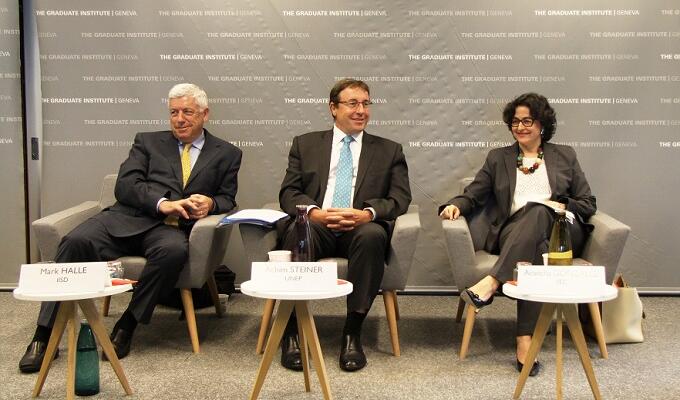

New Handbook on Trade and Green Economy Launched in Geneva (en)
A once-antagonistic relationship between the trade and environment policy communities has evolved into recognition that the two have complementary roles to play in sustainable development, the heads of the United Nations Environment Programme (UNEP), ITC, and the European wing of the International Institute for Sustainable Development (IISD) think tank said in Geneva this week.
Speaking at the launch of ‘Trade and Green Economy: A Handbook’, a UNEP-IISD publication to which ITC had provided editorial content and financial support, the speakers stressed that transitioning to a green economy would be crucial to meeting both development needs while preserving the natural environment.
The new handbook, the third edition in a series dating back to 2001, makes clear the complex relationship between increased trade and environmental protection. On the one hand, increased trade and economic activity are often associated with greater carbon emissions. On the other, trade spreads low carbon technologies swiftly, and product standards and regulations can serve as incentives to improve environmental practice.
Hailing the work with UNEP as an example of the UN system ‘delivering as one’, ITC Executive Director Arancha González said that greening value chain production and public procurement would contribute to achieving the prospective Sustainable Development Goals. Aid for trade and targeted government policy could play a role in both, she suggested. González also emphasised the importance of domestic policy in making trade contribute to sustainable growth, and warned that trade rules could not replace domestic action. ‘The lessons from this book show that raising trade barriers does not provide the right solutions,’ she said. ‘Pricing carbon and introducing strong national environmental legislation does.’
UNEP Executive Director Achim Steiner said that the shared pursuit of a green economy offered an alternative to unnecessarily adversarial approaches to trade and environmental negotiations. ‘The objective of this handbook is to increase coordination and reduce tension between the international trade and environment agendas,’ he said. ‘Doing so will allow the power of trade to open new pathways to achieve sustainable development.’
‘It is important to think what economy we want first and then see how trade dynamics can participate to the transformation of economies and societies,’ said Mark Halle, Executive Director of IISD-Europe. ‘The challenge is to ensure that transformative power is directed toward sustainable development outcomes, both within countries and globally.’
ITC is committed to projects that increase trade opportunities for vulnerable groups whilst strengthening environmental resilience. For example, In Kenya, ITC is training thousands of tea and coffee farmers on climate smart agriculture techniques and more sustainable value chain processing. The result of these interventions more efficient fuel use and increased income streams for the marginalized rural populations, particularly women, working in these agricultural and natural resource value chains.
Product standards, including the growing number of private sustainability standards, can shape green economy pathways, but also risk shutting out developing country producers unable to understand or comply with them. ITC’s Standards Map provides transparency on several hundred private voluntary standards so that both buyers and sellers of certified goods understand their principles and criteria effectively.
For more on ITC’s Trade and Environment Programme, click here
For more ITC’s Standards Map, click here



